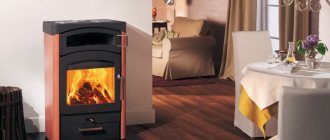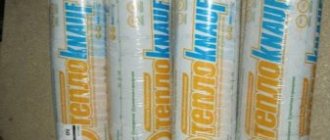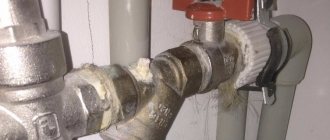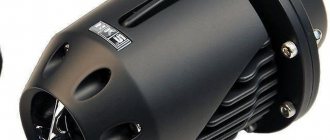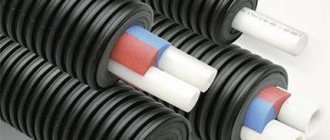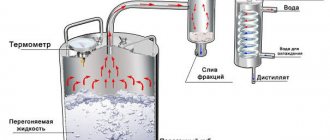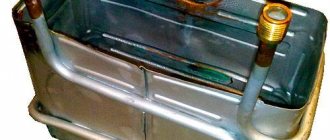During the cold season, residents often complain about problems with heating appliances. The radiators heat weakly or partially, so the air temperature in the apartment is below normal. What to do in such a situation?
Let's consider a way to improve the situation, correct a situation that brings discomfort and unnecessary costs, namely a heating radiator flow extender .
- What is a flow extender
- Where are flow extenders installed?
- Review of popular brands
- How to make it yourself
- Installation features
What it is
With a side connection, which most often occurs in apartments, the hot coolant enters from above, then through the control valve it supplies hot water to the radiator.
If we analyze the situation, then with good circulation, the water should pass in a circle from the upper position along the perimeter of the radiator to the lower one and exit into the pipe (return).
Thus, hot water flows to all sections of the radiator. But with insufficient circulation, heat does not reach all elements, makes the circle smaller and returns to the riser, thereby not completing the full cycle of passage through the radiator.
Radiator flow extension
To solve such problems, there are special radiator flow extenders. This additional element allows you to deliver hot flow to all sections of the radiator.
The part is designed to ensure that the coolant is directed in the desired direction to pass through the entire section of the radiator: from beginning to end. So heat transfer occurs in full.
A flow extension for a radiator is a part structurally similar to a fitting, with connecting dimensions of ½' or ¾'. Futorka is a device for connecting through threads inside and outside parts or structures. You can make a futorka at home with your own hands on a machine from a steel billet. The bushing will be threaded on both sides.
The internal one is for fastening the extension pipe, the external one is for connecting to the main pipes through the valve structure. In this case, the fitting connects the main coolant pipe and the extension (the pipe passing inside the lower part of the radiator).
The pipe can be made of the following materials:
- metal-plastic;
- polyethylene;
- stainless metal;
- become;
- copper
It is worth remembering that under no circumstances should you use copper tubes and parts in combination with aluminum radiators, since the metals oxidize upon interaction.
Flow extension (duct) for a bimetallic radiator - Construction
07.12.2019
Flow extender: where to buy, how to make a heating extension, where to put it in the radiator?
When new radiators freeze in the first winter: the first 2-3 sections are hot, the rest are cold - many begin to look for a method of “how to direct the coolant to the distant sections.”
And in the web they find such a divine solution as a flow extender
: you can install it yourself like an amateur and you don’t even need to remove the risers!
And no messy alterations of connection diagrams with burnt wallpaper from welding. In general: the naive dream of any spider.
Flow extender - this tube is inserted into the inside of the radiator after the tap.
With this flow extender: all sections are heated more or less evenly: the water has reached the end of the radiator. It seems like everything is fine!
But in reality, everything is not so: the temperature of the radiator is much lower than the temperature of the risers:
The risers are hot, but the battery is just warm.
Maximum heat transfer can be obtained by moving water inside the radiator from top to bottom: only with such circulation is the natural circulation gravity pump
and the main factor of non-heating (the most important problem) is the draining of the cooled coolant from the radiator from above. A flow extender does not correct this factor!
When the flow is extended in half of the sections, the water moves from bottom to top - again a loss of 50% of gravitational circulation.
And this tube inside the radiator will narrow the upper or lower battery collector. There are already two flows: inside the tube itself and outside between the walls of the radiator.
If the diagonal is incorrect (the diagonals for the top and bottom feed are completely different and are not interchangeable), at least all the pipes pass outside: there are no narrowings inside the battery.
Mixed up diagonal
- and it gives more heat than this extension cord! But you won’t get warm on it either - I’ve already remade it.
To avoid waste coolant escaping from the top of the radiator
— it is better to use a bottom connection: a bottom-to-bottom circuit.
In this scheme there is no concept: distant sections - the entire radiator is also heated evenly as with an extension cord and even better: there is less difference in the temperatures of the riser and the radiator.
But the loss of heat transfer against the upper spill is up to 30% - it depends on the internal flow area of the vertical channels in the sections - it is better to choose radiators with large diameters.
There are imported extension cords on sale for true bottom connections: when plastic pipes run through the floor of the apartment and exit from below under the radiator itself, there are no steel heating risers in the corner of the room.
And many begin to think: this is a factory-certified product, which means it works! Yes - this extension cord works!
But it works in a 2-pipe collector system (there is a pressure difference in the supply and return risers), where all apartments are connected in parallel, and it often happens that the radiators inside 1 apartment are in a parallel circuit.
And the problematic bottom supply is a single-pipe system with a vertical riser inside the room: the pressure in the pipes in front of the radiator is the same (the bypass jumper in front of the battery completely equalizes) and all the radiators on the riser are connected in series.
- In an imported extension cord there is no outlet of waste, cold coolant from the top of the radiator.
- And in fact, it has a purely decorative function: 2 pipes side by side enter the radiator from below from the floor.
- And without an extension cord, the connection will be: 2 tubes separately at the ends of the battery - this is kind of less beautiful!
- This imported hydraulic extension works like a BOTTOM-BOTTOM circuit - just a slightly different visualization.
- There is also a more expensive bottom connection unit for plastic pipes in the floor: an additional external supply pipe to the top of the radiator.
Can it be used everywhere?
The flow extender is installed in the lower part of the heating structure. Where the water drains out, at the radiator outlet.
Thus, the hot coolant enters the upper hole, passes through all sections of the radiator and enters the farthest corner diagonally to the inlet. Then the water flows into the installed extension tube. This way the fluid circulates through the radiator much better.
The circulation of water, that is, the coolant, occurs diagonally. This circuit is suitable for connecting the radiator to the battery sideways.
Let's look at an example of how to install a flow extender.
In old-style batteries (cast iron), it is installed extremely rarely. For a bimetallic radiator, you can use a flow extension only if the connection is on the right or left. Water inlet and outlet should be on one side.
So, using the example of a lateral connection, we will consider installing a radiator flow extension.
Serial and parallel connection of a heating radiator
In this device diagram, the coolant approaches the radiator from the side, from the top corner. This part can be left in place by turning off the tap of the flow of liquid into the radiator.
We are now working only on the lower part, where the water leaves the device, giving up its thermal energy. This will save both time and effort.
Node connection diagram
The connection of the lower node is carried out according to several schemes.
Via bypass
Bypass reduces heat loss by approximately 20%, which saves money
Bypass is implemented through:
- Built-in channel with adjustable hole diameter. It can be connected to single-pipe communications for uniform distribution of water temperature. Using eccentric nuts, you can connect pipe bends with any axial distance.
- A remote element to increase the inlet temperature with subsequent equalization in the system. The tube is connected through a fitting with a built-in thermostat. The coolant will be directed through the bypass to the top of the battery and flow down. To regulate the return flow, an air bleeder is built into the upper part.
Through the injector
The injection, or lower side, method requires the presence of special devices. The injectors are made in the form of a pipe installed in the outlet pipe body. A special feature of the scheme is the direction of hot coolant into the battery through the inlet near the pipe and return through it to the return line. On the side of the injection device there is a valve regulator, screw or automatic thermostat.
Tichelman wiring
Tichelman wiring does not allow the coolant to cool completely
Relevant for single-pipe heating systems. The main line is retrofitted with associated wiring with the same total distance for the supply and return lines.
Using flow extenders
The device is mounted at the bottom and has no outlets to the top. The coolant circulates, moving to the middle of the battery, and then exits at the end. It rises and pushes water through the outlet pipe. Flow extenders are not used in gravity lines.
Using an adapter
The element is screwed in at the bottom, and a stainless steel pipe is directed up. Heating pipes are connected to the adapter from below.
Review of popular brands
There are two leading companies on the market producing radiator flow extenders and heating systems.
Flow extension for VALTEC radiator is the most popular solution. VT. 503 is an abbreviated name for the system. It is manufactured in two types: right (D) and left (S). The exclusive part system was developed by VALTEC engineers.
The use of an extension cord is the best solution for operational problems when the heating system does not deliver a flow of hot liquid deep into the radiator. VT. 503 is a brass alloy sleeve with a nickel coating that protects the part from the external environment and metal irritants.
Heating radiator extension VT. 503
The fitting pipe has an internal thread through which an extension pipe of the required size is attached. The length of the pipe is 6–8 cm shorter than the radiator. If there is a thread in the pipe, fastening does not require additional tools; it is done by screwing in.
It should be noted that the parts have a service life of up to 50 years. The test pressure corresponds to 24 bar. Working pressure 16 bar. The sealing agent is silicone. Scope of application: cast iron, aluminum, bimetallic sectional radiators.
The radiator flow extender from Rifar is also not a bad solution. The company produces bimetallic and aluminum heating systems from various numbers of sections. Suitable for use in Russian conditions for private houses and apartments, for arranging heating systems in apartment buildings, enterprises and other premises.
The company is located in the city of Gai, Orenburg region. Convenient location allows you to expand the sales market in all directions. The company's central office is located in Moscow. Rifar company was founded in 2002. A year later, the production of radiators under the brand name began. The company's branded product is bimetallic radiators.
Product improvement occurs every year. A big event was the release of radiators of a new design, which has no analogues in the global industry - MONOLIT with a pressure limit exceeding 150 atmospheres.
Flow extenders are suitable for radiators, both in a monolithic design and in a prefabricated design. Thus, extension cords from other companies are best suited for the rifar brand, since all Russian manufacturers adhere to standard sizes and material combinations.
Radiator extension Rifar
Rifar is the world's strongest competitor in the production of equipment for plumbing and heating systems. Currently, radiators with a heating system connection, where both the inlet and outlet of the heating fluid are at the same level, on one side, are in great demand.
This type is in demand due to its convenient installation, repair and maintenance, despite the increased price. The latest Rifar models are available with an integrated radiator flow extension design. Suitable parts are provided for different battery models. Most of them are 0.75 inches. The Rifar company mainly produces sectional radiators, using bimetal and aluminum for their production.
Materials for homemade carrying
To make an extension cord with your own hands, you will need:
But this set seems banal only to the untrained eye. The fact is that depending on the cable parameters:
- Wire material;
- Type of insulation;
- Conductor cross-sectional area;
- Lengths.
It will depend on how much total power of electrical appliances can be powered through a homemade extension cord.
Ratio of maximum power and wire length
It is best to gradate extension cords according to the connected power and cable length. For example, when used inside an apartment, the maximum load can rarely exceed 3 kW:
- TV - 100 W;
- Iron - 1000 W;
- Microwave - 1.8 kW;
- Laptop + router + 3 LED lamps - 100 W.
IMPORTANT: devices must not only be connected, but simultaneously operate at maximum load. For a cottage or garage, it is better to make a carrier designed for higher power, well, at least 6 kW
But here the cable length factor intervenes. The dependence can be seen in the table
For a cottage or garage, it is better to make a carrier designed for higher power, well, at least 6 kW. But here the cable length factor intervenes. The dependence can be seen in the table.
For an apartment, a 10 meter long carrier will cover the needs in 99.9% of cases. For a summer house, garage and other household needs, it is better to make an extension cord on a reel with your own hands, with a cable 40-50 meters long. This will a priori solve almost all possible needs.
Cable or wire
Unlike a wire, a cable has additional, general insulation of conductors, which allows it to be laid in the ground, or temporarily placed on the ground, in the open air. Therefore, for indoor use, you can use a wire, and for universal carrying, a cable.
IMPORTANT: for extension cords, always use only cable products with stranded copper cores. The main requirement for an extension cable is flexibility.
Therefore, when choosing materials, all types of cables with aluminum conductors, as well as single-core copper wires, are eliminated from the list of candidates.
The main requirement for an extension cable is flexibility. Therefore, when choosing materials, all types of cables with aluminum conductors, as well as single-core copper wires, are eliminated from the list of candidates.
FOR REFERENCE: according to GOST 15845-80, a stranded cable should be distinguished from a cable with a stranded copper core. In the first case, each core inside the cable has its own insulation. In the second case, several thin wires are twisted into one core and have a common insulation.
The electrical cable for the extension cord must be marked PVS or PBPPG. Their difference is that PBPPG is flat, and PVS is round.
There must be three wires in the cable! Grounding is a function of an extension cord that is better to have and not use than to complain about its absence after a tragic incident.
As practice shows, it is best to make an extension cord with a straight plug.
The wire fits to it along the axis, without bending. In some cases, this feature can be decisive when connecting in places with poor access. An eyelet on the plug makes it easier to disconnect and can be used for hanging.
Almost all plugs have a ground connection. Protection class not lower than IP44.
What does IP44 protection class provide?
If the connection at the plug and socket is correctly assembled, then the IP44 protection class allows you to leave them in wet rooms, they are not afraid of splashes. If the contact group is suspended above the ground, then the carrier can be left in the rain.
Socket block
There are two categories of products that are very similar in appearance
- Overhead sockets;
- Block (block) of sockets.
Such devices are easily distinguished when viewed from the back.
Please note that the socket block does not have special holes or slots for fastening on the back side. For the extension cord, you need to choose exactly the socket block
It may come with a switch
It doesn't make any fundamental difference. But do not forget that grounding must be required.
How to choose the protection class of a portable socket block is important if the extension cord will be used outside the apartment, such as in the country house, in the garage or even in nature. For universal carrying, the marking must indicate IP44.
How to make it yourself
- You need to close the taps, drain the water and remove the heating structure.
- Carefully, in order not to damage the paint, you need to unscrew the top plug with the installed part of the detachable fastening.
- It is necessary to connect the pipe and sleeve using soldering. You can use fat for soldering as flux and soft solder. The parts are connected and both elements are heated by a burner. You can take a standard small burner, guided by lighter gas.
- After this, solder is applied to the joint. If heated correctly, the solder melts and flows into the joint.
- The diameter of the American from the inside after cleaning from plaque is 19 mm. The coupling diameter is larger. Using a small file, you need to remove the excess to such a state that you can hammer it in with a hammer. However, you should do this carefully so as not to harm the parts. To do this, when hammering, you can take wood spacers.
- That's all. All that remains is the installation of the duct extension for the radiators. You need to “play” with the length. Depending on the water supply, sometimes it is better to leave the length to the middle of the battery. However, you can always cut it off.
- The flow extension and gasket are installed, the radiator is put in place. The work is finished.
- All that's left is to let the air out.
Key stages in the manufacture and assembly of an extension cord coil
1. Making a bushing for the drum. A universal homemade extension cord reel will rotate
Therefore, it is important to make a reliable bushing with locking washers. To do this, you need to take a pipe with a cross section of 20 and 25 mm
The material is cut to the width of the drum, taking into account the installation of the fixing bolt. In this case, a tubular element with a cross-section of 20 mm must be cut with a margin of at least 5 mm in width. The smaller pipe diameter should fit freely inside. On the sides of the axle, bushings machined from steel 2-4 mm thick are installed. The moving element is fixed with an M8 or M10 bolt.
2. Stand for the reel made of profiled pipe. In the instructions in the photo, which shows how to make a reel for an extension cord, there is a structurally important element - a U-shaped stand. This part can be made from sections of profiled pipe 20x20 mm and 20x40 mm
Initially, it is important to determine the dimensions of the structure taking into account the dimensions of the rotating drum. A 20x20 mm pipe is cut to the required parameters and welded together in the shape of the letter P
The central part is marked in the center. After which a 20x40 mm pipe is welded vertically.
Important: The 20x40 mm pipe must be welded as evenly as possible so that in the future there will be no difficulties with rotating the drum. To do this, it is recommended to use a square or a building level.
3. Attaching the drum axle to the stand. The axle must be welded to a 20x40 mm pipe. It is first necessary to note the height position of the drum. A 20 mm round pipe is welded to the profiled electrode welding. You will also need a thrust washer, which will act as a retainer for the drum. If necessary, the washer can be welded to the profile.
4. Handles for the reel and supporting frame. Handles are necessary for ease of use of the reel. Handles from a grinder or drill are suitable as the main elements. The large handle must be secured to the upper part of the 20x40 mm profile using a nut. The small one should be located on the coil itself. The handle for rotating the drum can be made from a bolt or pin. A handle with a roller will also work. In this case, you can get a smoother operation of the rotating mechanism.
5. Installing sockets on the coil. Before reading how to make a reel for an extension cord with your own hands, you need to purchase all the components to assemble the product. For normal operation of the device, you must purchase panel sockets. This type of socket is quite convenient and most suitable for installation. Installation options are shown in the photo below. For reliability, the socket can be secured with self-tapping screws with a cap. The socket fasteners are selected individually, taking into account the width of the plastic drum.
6. Installing the drum on the axle. After installing the sockets and handle, the coil must be secured to the axis. To do this, a drum with a sleeve is placed on a 20 mm pipe. The outer part of the axle is fixed with a bolt or nut, depending on the type of design chosen. The locking mechanism should be tightened taking into account the free rotation of the drum. After tightening, the coil should not jam.
7. Winding the electrical cable onto a reel. For the intended use of the product, you will need to wind the cable. Almost any wire with a core cross-section of 1.5-2.5 mm2 will do. Winding must be carried out taking into account the cable fixing mechanism. There must be a plug at the end of the wire for inclusion, and the installed sockets must be connected in series. The number of sockets depends on the overall dimensions of the drum.
Important: For safety reasons, all contacts should be insulated. For production we will need:
For production we will need:
- steel square 10 mm - 1 m long.
- stud with nut with a diameter of 10-12 mm - length 170 mm.
- a handle, for example from an angle grinder.
- coupling 100 mm and two plugs for it
- two circles of plywood with a diameter of 230 mm
- 8 mm stud - length 1 m and 6 nuts and washers
- three sockets and one plug
- the wire
Peculiarities
A duct extension for a radiator is a ½- or ¾-inch fitting-type part with an outlet for connecting a metal-plastic, polyethylene, stainless steel or copper “extension pipe”, which is installed on the return connection of the heating structure and facilitates the movement of the coolant diagonally in the battery when lateral connection.
An extension cord is used, as a rule, for batteries with a number of sections of ten or more.
It can be used for batteries connected to the heating system of the house through standard taps with an American connection: there must be a shut-off valve on the coolant return and supply circuit. If it is missing, you will not be able to connect such an extension cord for a bimetallic radiator. You will have to call a technician and do the labor-intensive job of reconnecting the battery.
Operating principle of a flow extender for a radiator
The main problem with an extension cord is that it is not that easy to get. It is rarely found in a plumbing store. This is a cheap device and is not in great demand, so there is no point in releasing it. The same situation applies to online stores. For example, the Valtec VT.503 flow extender costs from 219 rubles. However, there is a way out - you can assemble and install the flow extension for the heating radiator manually.
